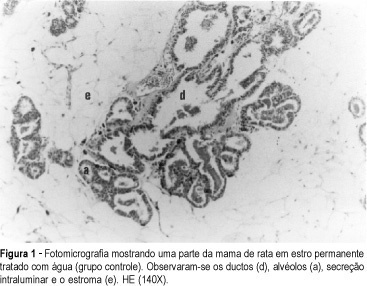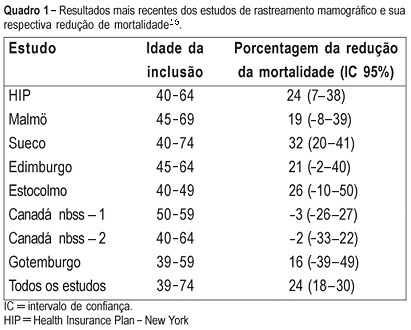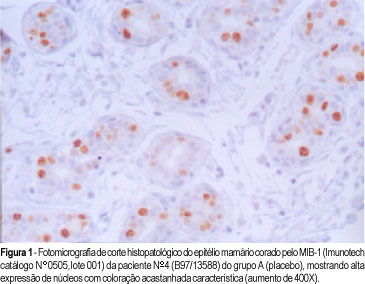You searched for:"Geraldo Rodrigues de Lima"
We found (29) results for your search.Summary
Rev Bras Ginecol Obstet. 2003;25(5):353-358
DOI 10.1590/S0100-72032003000500008
PURPOSE: to determine interobserver reliability of site-specific measurements and stages according to the proposed International Continence Society prolapse terminology document. METHODS: we analyzed 51 women during urogynecological investigation performed at the Urogynecology and Vaginal Surgery Sector of UNIFESP / EPM. We recorded the locations of point-specific measures proposed by the International Continence Society (ICS). They are: two in the anterior vaginal wall, two in the superior vagina, two in the posterior vaginal wall, genital hiatus, perineal body and total vaginal length. Then we recorded the stage of genital prolapse. Women underwent pelvic examinations by two investigators, each blinded to the results of the other's examination. The reproducibility of the nine site-specific measurements and the summary stage were analyzed using Pearson's correlation coefficient and the median measurements were compared by the paired-t test. RESULTS: there were substantial and highly significant correlations for each of the nine measurements. Correlation coefficient for point Aa was 0.89 (p<0.0001), point Ba 0.90 (p<0.0001), point C 0.97 (p<0.0001), point Ap de 0.72 (p<0.0001), point Bp 0.84 (p<0.0001), point D 0.91 (p<0.0001), genital hiatus 0.65 (p<0.0001), perineal body 0.66 (p<0.0001) e total vaginal length 0.73 (p<0.0001). We also did not note differences between the means of measurements by the two examiners. Staging was highly reproducible (r=0.81, p<0.0001). ln no subject did the stage vary by more than one; in 86,2%, stages were identical. CONCLUSIONS: there is a good reproducibility of measures using the system proposed by the International Continence Society prolapse terminology document.

Summary
Rev Bras Ginecol Obstet. 2002;24(6):365-370
DOI 10.1590/S0100-72032002000600002
Purpose: to study the relationship between pelvic floor function and bladder neck mobility in women with and without stress urinary incontinence (SUI), in menacme and postmenopausal. Methods: sixty-one SUI patients were evaluated; 31 of them were in menacme and of these 17 had SUI and 14 did not have any complaint; 30 were postmenopausal and of these, 15 with SUI and 15 without SUI. Simple cystometry and empty supine stress test were performed in those who had urinary incontinence complaint. Bladder neck mobility was studied by ultrasound and by the Q-tip test. To study pelvic floor function, vaginal cones and digital palpation were used. Results: the bladder neck position in the incontinent women (Groups A and C), determined by ultrasound or the Q tip-test, was --11.8 cm in Group A and --12.5 cm in Group C, lower than the continent women, in whom the bladder neck was at +4.4 cm in Group B and +2.3 cm in Group D. There were no differences in bladder neck mobility among the continent menacme (9.1 cm) and postmenopausal (9.5 cm) groups. Also there were no differences among the incontinent groups (17.1 cm for Group A and 16.6 cm for Group C). The bladder neck mobility was greater in the incontinent women (A and C). Continent women had better results on evaluation of pelvic floor muscles than the incontinent ones, even using vaginal cones or digital palpation, and these results were not dependent on the hormonal status. Conclusion: a positive correlation was found between the Q-tip tests and ultrasound, and between test with vaginal cones and digital palpation. No significant correlation was found between pelvic floor function and bladder neck mobility.
Summary
Rev Bras Ginecol Obstet. 2004;26(1):37-42
DOI 10.1590/S0100-72032004000100006
PURPOSE: to evaluate the accuracy of directional vacuum-assisted biopsy (mammotomy), guided by ultrasonography, in the diagnosis of nonpalpable breast lesion, as compared with excision biopsy, and to evaluate the therapeutic value of mammotomy in nonpalpable benign lesions. METHODS: 114 patients, who presented nonpalpable breast lesion, visible on ultrasonography, were included. The patients were referred to complementary ultrasonographic evaluation due to mastalgia or earlier found mammographic alteration. All were submitted to mammotomy guided by ultrasonography using Mammotome® (Biopsys, Irvine, Califórnia), with a 11 gauge needle. The excision biopsy was performed with previous puncture of those patients who presented residual lesion after the mammotomy, that is, 88 patients. To evaluate comparatively the mammotomy results with those of excision biopsy, the sensitivity and specificity rates, positive and negative predictive values, and the agreement proportion were calculated. Not only the sensibilities, but also the specificities and the agreement proportions of both examinations were compared through Wald statistics, using a model for classified data. RESULTS: of 114 patients, 88 were submitted to excision biopsy. The remaining 26 did not show post-mammotomy lesions visible on ultrasonography, and for one year they were without alterations on the bi-annual mammographic and ultrasonographic examinations. The diameter of those lesions was less than 1.5 cm. Among the 88 patients that underwent excision biopsy, 69 (78,4%) showed benign and 19 (21,6%), malignant lesions. Mammotomy diagnosed 16 of the malignant lesions, with three false-negative and no false-positive results. The false results occurred in the first cases, showing the existence of a learning curve of the method, or due to technical difficulty such as the blurring of ultrasonographic image by bleeding. The sensitivity and specificity were 84,2% and 100%, respectively, with 100% positive predictive and 95,8% predictive negative values. The mammotomy accuracy was 96,6%. Complications were rare: two cases of hematomas, none of them needing surgical drainage; a case of vasovagal reflex not allowing the conclusion of the examination. The cosmetic results were very favorable due to small incisions (3 mm) and to the smaller amount of excised tissue. CONCLUSION: mammotomy guided by ultrasonography showed to be a diagnostic method with high accuracy, and it may be used as therapy for benign, smaller than 1.5 cm lesions.
Summary
Rev Bras Ginecol Obstet. 2001;23(1):41-45
DOI 10.1590/S0100-72032001000100006
Purpose: the morphologic and morphometric aspects of the breasts of rats in permanent estrus submitted to danazol were studied. Methods: the animals were divided into three groups: group A (n = 12) received water and was used as control, group B (n = 13) was exposed to 20 mg danazol kg-1 day-1, and group C (n = 10) was exposed to 80 mg danazole kg-1 day-1 for 35 consecutive days. The microscopic study evaluated the ductal and acinar distribution. Histometry of the relationship duct/stroma was based on the principles of stereology with a Zeiss k-10X ocular, with Integrationsplatte I reticulum of Weibel of 25 hits, with 100X magnification. For each studied section, 10 aleatoric fields were counted, with a total of 250 points. The variance analysis test (Kruskal-Wallis) was applied to compare the three groups in relation to the mean number of alveoli and ducts (alpha = 0.05). Results: when submitted to morphological study, all groups presented lobules with alveoli lined with cubic cells with nuclei in their central or basal portion. Small amounts of eosinophilic material were observed in some cases in the lumen, with no differences between the groups. At morphometry, with a magnification of 100X, a mean number of 28.6 ducts/10 fields was found in group A, 28.4 in group B and 29.2 in group C (Kruskal-Wallis test: Hcrit = 0.1). The mean number of alveoli in 10 fields was 5.9, 9.3 and 6.5 in groups A, B and C, respectively (Kruskal-Wallis test: Hcrit = 2.9), with no significant differences between the groups. Conclusion: danazol did not cause any changes in the morphology and morphometry of the permanent estrus mammary epithelium.

Summary
Rev Bras Ginecol Obstet. 2005;27(7):415-420
DOI 10.1590/S0100-72032005000700008
PURPOSE: to evaluate the cost of preventive mammographic screening in climacteric women, as compared to the cost of breast cancer treatment in more advanced stages. METHODS: one thousand and fourteen patients attended at the Climacteric outpatient service of the Gynecology Department, Federal University of São Paulo Paulista School of Medicine, were included in the study and submitted to mammographic test. All mammographic test's were analyzed by the same two physicians and classified according to the BI-RADS (Breast Imaging Reporting and Data System American College of Radiology) categories. The detected lesions were submitted to cytological and histological examination. RESULTS: the final diagnostic impression of the 1014 examinations, according to the classification of BI-RADS categories was: 1=261, 2=671, 3=59, 4=22 and 5=1. The invasive procedures were performed through a needle guided by ultrasound or stereotactic examinations: 33 fine-needle aspiration biopsies, 6 core biopsies guided by ultrasound and 20 core biopsies guided by stereotactic examination. Five cancer diagnoses were established. The total cost of this screening based on Brazilian procedure values was R$ 76,593.79 (25,534 dollars). Therefore, the cost of the diagnosis of the five cases of cancer in this screening was R$ 15,318.75 (5,106 dollars) each. However, the average cost per patient screened was R$ 75.53 (25 dollars). CONCLUSIONS: considering that the total treatment cost of only one case of breast cancer in advanced stage including hospital costs, surgery, chemotherapy, radiotherapy and hormonal treatment is similar to the cost of 1,000 mammographic screenings in climacteric women, it may be concluded that the cost of the early cancer diagnosis program is worth it and should be included in the public health program, as a way of lowering the public health expense.

Summary
Rev Bras Ginecol Obstet. 2000;22(7):429-433
DOI 10.1590/S0100-72032000000700005
Purpose: to study the monoclonal antibody MIB-1 in the normal breast epithelium adjacent to a fibroadenoma in women in the luteal phase of the menstrual cycle treated with tamoxifen. Patients and methods: the proliferative activity of the mammary epithelium adjacent to the fibroadenoma was studied by immunohistochemistry based on immunoexpression of the monoclonal antibody MIB-1. The study was randomized and double blind and was conducted on 44 women with fibroadenomas, divided into 3 groups: A (n = 16; placebo), B (n = 15; tamoxifen, 10 mg), and C (n = 13; tamoxifen, 20 mg). Tamoxifen was administered for 22 days starting on the 2nd day of the menstrual cycle and a biopsy was taken on the 23rd day. Results: the mean percentage of stained nuclei per 1000 cells was 9.2 in group A, 4.5 in group B, and 3.2 in group C. Fisher's test revealed that tamoxifen significantly reduced the immunoexpression of MIB-1 at the doses of 10 and 20 mg compared to the placebo group (p<0.0001), with no significant differences between doses in terms of proliferative activity (p = 0.21). Conclusion: we conclude that tamoxifen significantly reduced the proliferative activity of the mammary epithelium at the doses of 10 and 20 mg/day.

Summary
Rev Bras Ginecol Obstet. 2002;24(7):433-438
DOI 10.1590/S0100-72032002000700002
Purpose: to analyze the correlation between Valsalva leak point pressure and maximum urethral closure pressure and clinical symptoms in women with stress urinary incontinence. Methods: we analyzed retrospectively 164 patients with urodynamic diagnosis of stress and mixed urinary incontinence established by the Urogynecology and Vaginal Surgery Sector of UNIFESP/EPM. All patients were submmited to medical interview, physical examination and urodynamic study. Patients were divided into groups according to the subjective degree of stress urinary incontinence. Valsalva leak point pressure (VLPP) was measured with a vesical volume of 200 mL. Urethral profile was determined using a flow catheter number 8 with measurement of maximum urethral closure pressure (MUCP). Data were compared by chi², ANOVA and Tukey tests. Results: mean age was 51.2 years (19-82), 76 women (47.2%) were in menacme and 85 (52.8%) in postmenopausal status. Mean parity was 3.9 (0-18). The exact test for trend demonstrated a statistically significant (p<0.0001) correlation between the number of patients with VLPP of 60 cmH2O or less and clinical complaints. The group with severe leakage had mean VLPP of 69.1 cmH2O. The group with moderated leakage had mean VLPP of 84.6 cmH2O and the group with mild leakage had mean VLPP of 90.6 cmH2O. Conclusions: VLPP correlated with the subjective degree of stress urinary incontinence. Higher grades of stress urinary incontinence had a higher likelyhood of a low VLPP. MUCP did not correlate with clinical complaints.
Summary
Rev Bras Ginecol Obstet. 2001;23(1):47-51
DOI 10.1590/S0100-72032001000100007
Purpose: to evaluate the incidence of thermal damage to the specimens excised through large loop excision of the transformation zone (LLETZ) and to determine qualitatively and quantitatively the thermal injury to the ectocervical and endocervical epithelia as well as the influence of the menstrual phase on such process. Methods: we performed a prospective study of 100 patients with high-grade squamous intraepithelial lesions (HGSIL). Thermal damage was subdivided into three grades according to Messing et al¹. Results: thermal injury occurred in all the cases, however, through statistical analysis we found that in 91% of the cases it was insignificant, thus leading to a precise histological evaluation, hence to measure the thermal injury was unnecessary. The grade and extent of thermal damage in excised specimens using LLETZ had no relation to the menstrual phase. The extension of thermal tissue alteration in the endocervical epithelia was 271,6 mu while the extension in ectocervical epithelia was 254,8 mu, showing that the extension of thermal damage is significantly higher in endocervical epithelia. Of the one hundred patients, 80 were in menacme and 20 in menopause correlating the grade and extension of thermal damage with the menstrual state. Conclusion: there was no significant difference in both qualitative and quantitative evaluations. There is no need to measure the thermal damage.